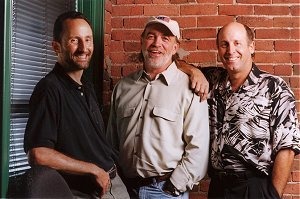Along with all the other foolish things I do, I’ve made the better part of my living designing and developing personal and commercial websites. I’ve been doing it since 1995, when the “World Wide Web” was taking its first steps and beginning to elbow its way into all of our daily lives. The “Web”, as we called it, was everything and everywhere, and with great enthusiasm, everyone wanted to get in on it. Judging by the landscape today, they did.
Way back there in ’95, two friends and I started a website in Nashville named “The National Online Music Alliance” (NOMA). None of us had any money, so Paul Schatzkin, Tom Kimmel and I “capitalized” our little start-up business with three personal checks – we each put in $250.00-$300.00 – enough for office supplies and a dial-up internet connection. We contacted all of our singer/songwriter pals and worked the Nashville community for potential “members” who were out on stage every night with CD’s and cassette tapes to sell. A few months later we were selling CDs and downloadable songs for a hundred independent recording artists and performers and the business took off. It grew month by month and the three of us never put another dollar of our own money into it.
Five years later that company had morphed into a “digital domain” known by then as Songs.com. It was truly one of the first online “communities” and had grown to over 600 recording artists, 1500 static web pages, 2000 products and was selling a CD or download every fifteen minutes, 24/7. We had a mailing list and newsletter that went out twice a month to as many as 20,000 regular patrons, and along with three or four part-time dedicated employees (many thanks to you!) we worked our fingers to the bone (literally) keeping that company afloat and on time selling, shipping, and promoting music around the world.

Tom Kimmel – Yours Truly – Paul Schatzkin
The success of our little company was built on two basic concepts – interesting, full-of-information web pages, and consistent communication with our visitors.
We sold Songs.com to Gaylord Entertainment in 1999 and the three of us were put alongside five other corporate V.P. managers of what was meant to become the largest digital assets repository in the world. It didn’t become that. Instead, corporate nonsense left it in the dark and out in the cold, their very huge $50 million dollar mistake. I retired two years later. The rest of that is just old forgotten history.
The web pages we designed for Songs.com artists in the 90’s were, to say the least, comprehensive. We filled every page with as much blah-blah and information as the screen allowed. Pages were full of text, small place-holder graphics and “click here” links to take you to the next page of blah-blah. Back then, “everything” was in. Our visitors didn’t seem to mind… they’d stay on the site for hours.
Not so, today.
Since those early years in Nashville I’ve built three other web-based companies, two of them as a contract programmer and copy writer. One company took six years to build. Many of the strategies and concepts I learned in those early years helped to take all of them to six or seven-digit gross $ales within three to five years, so we must have done something right. All are still operating and growing.
I’ve designed and coded over 10,000 web pages since 1995 and continue to manage more than 40 Internet domains and their websites for clients all around the country. I’d say I’m an average-skilled programmer in several program and scripting languages, PHP a personal preference. Most recently, I’m courting WordPress. Everything’s already under the hood and running.
I tell you all of that to say this: I feel I’m qualified to tell you… things have changed… again.
The Ever-Changing Landscape
I can’t count the times I’ve consulted with clients who want to know why they’re not getting lots of “hits” on their websites. My response is always the same… “Read up”. The information’s been out there awhile and if you haven’t kept up you’re already behind. Things have changed again in the world of web. Faster. Real-time. Now.
When people’s tastes and habits change, new designs and architecture always follow. The visitors follow that.
Website Design and the way we “consume” web content has always changed dramatically over the years, but never more than since the up-take in smart phones and tablets. People have become all but one-handed in just about everything they do. The cell phone is always in the other hand. If you don’t believe me, just leave the house some morning without it. Watch how fast the nausea comes.
The desktop and laptop computer are fast becoming a thing of the past, used mostly by mid-life professionals and senior citizens (of which, unbelievably, I now am one). Some statistics suggest that the younger set of “Millenials” have grown up on cell phones and touch screen devices and have never been tied to a keyboard.
Keyboards are out. Reading is out. Scanning mobile touch screens and tablets is in.
“Thumbing” Our Way Through Life…
But you know that by now. All of us has suffered the annoying interruption of having to suddenly navigate around someone on the sidewalk who’s stopped dead in their tracks ahead of us to “thumb down” their iPhone screen looking for some kind of immediate information they can’t wait another minute for. It’s as if the world stops until they get the next piece of information they need to do the next thing they’ll do. They want it now, they want it quick, they want it all at the touch of their thumbs, and they don’t care if they’ve stopped in the middle of the street or sidewalk to find it.
I know… my sarcasm is detectable. But, what this means for the web development community is significant. It changes the way we do everything, and everything “old” needs to be brought up to date. In order to make a website “thumbable, fast and comprehensive” the entire design architecture and the developer’s approach to writing is a brand new game.
The longer you wait to upgrade and update your website, the farther your site will pass into the shadows of those that have.
Fact: Long-winded web pages and sites with dozens of pages, multiple menus, big paragraphs of small print and fill-out forms are abandoned by visitors within five seconds of hitting the site.
Website visitors don’t want to “click” anything anymore. They want to “thumb” down the page until they find what they’re looking for, read no more than three or four sentences and then move straight to the next piece of information. If they don’t find it in the first twenty seconds they leave and go to the next website.
Fact: Visitors seldom stay on any webpage more than 30 seconds.
![]()
Responsive Web Design
Today’s websites need to be graphic, comprehensive and need to work flawlessly on all devices; “thumbable” from top to bottom. Long, one-page “landing sites” with full-screen backgrounds salted with screen-wide pictures and two-sentence paragraphs with links to related information are the websites that have center stage. Sites that don’t conform to those rules take an immediate back seat to those that do, especially with Google ranking and prolonged visibility.
With these “responsive” designs, website functionality has started to make common sense. It’s faster, it’s easier, it’s uncluttered. Google and Microsoft love it. For the every-day user, it’s the only thing they have patience for.
“Let me find the page… let me read the page… let me leave the page”.
And… About Your Photos and Graphics…
Since we’ve all gotten used to “reading by picture”, the quality of your graphics has become more important than ever. You don’t have to be a PhotoShop master user, but learning a few things about getting crisp, in-focus digital photos is the best advice I can give. If your site is full of low quality images and nonsense graphics you need to address that right away.
Learning just a few things about resizing and enhancing digital photos can make a world of difference in the end result. Using full-size full-resolution images right from the camera is a no-no… it not only slows down your page-load time but also fills your website’s storage capacity with bulky, unusable files. And, if you don’t know what I’m talking about… you need to “read up”.
(I’ll do my best to post links to some free resources soon)
![]()
Summary…
Your website’s visitors are savvy and know what they’re looking for, and if they don’t find it in the first few “thumbs”, they’re gone. If you give them too much to think about, they won’t.
Responsive web designs are fluid and concise. It’s the only way to go in a world fast forgetting that the Web is still more than a glorified yellow-pages directory for finding the next place you’ll dance, eat or sleep.
You have 30 seconds to convince them to stay and see what you or your company are about.
Now look at your cell phone screen again…
![]()
